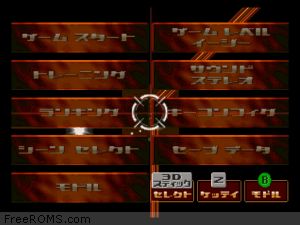
There are a few times where you need to use your sword in boss battles, which are actually pretty cool. There are a few times when the perspective changes to a side scrolling view, which is a cool change of pace, but the highlight of the game is a stunning sequence where you zoom haphazardly around a fleet of battleships – riding on what appears to be a sheet of metal, being telepathetically controlled – taking down an entire fleet of carriers and fighter jets, until you ascend into the sky and destroy a gigantic flying fortress piece by piece. It’s rare that a section goes on longer than it has to, and each is filled with boss fights that challenge your mastery of the control scheme. There are technically only three stages (in addition to a brief a prologue level), although each is broken up into several parts. Of course, like most Treasure games, it’s the level and boss design that really elevate Sin & Punishment to classic status. There is a “two player” option where one player controls the character movement while the other aims, which can potentially result in all kinds of hilarity. But once you do master them, every single other rail shooter seems simplistic by comparison. Even then, you get extra continues every time you kill one hundred enemies, so there’s plenty of room for error. Thankfully, like most Treasure games, you have a pretty huge life meter, and can sustain quite of bit of damage before you croak. Until you get to the stage where you master everything completely, you’ll probably find yourself making a ton of stupid mistakes, like walking straight into enemy projectiles or routinely falling into pits. That’s a whole lot of functionality to take on at once – it’s like trying to pat your head, rub your belly, chew gum, and solve trigonometry problems, all at the same time. You can also counter most enemy projectiles with your sword by highlighting an enemy with your crosshairs, waiting until the projectile is about to hit, then press Z to reflect it back. However, the shoulder buttons will make your character jump, which are really only used for a handful of sections with pits. Since the game is auto-scrolling, you can only move left or right. It only gets more complicated from there.
Sin and punishment n64 rom english free#
While this may seem simple, your shots are much weaker in this mode, so you need to get used to the free aim mode if you want to beat bosses within the time limit. The lock-on mode will automatically target an enemy once you’ve moved the crosshairs over it, so you’ll fire at it no matter where it moves. To aid with this, there are two firing modes – free aim and lock-on. In other games of this type, both the cursor and the movement are handled with the same input, so dividing up the functions alone takes a bit of getting used to. By default, the analog stick controls your crosshairs, while either the control pad or the C buttons controls your character’s movement, and the Z button fires your gun. The main difference is that you control human characters rather than dragons/starships, so you can’t fly around the screen. Sin & Punishment isn’t your typical 3D action game – it’s actually more of a rail shooter, similar to Panzer Dragoon or Starfox. It’s the brainchild of Treasure, the same guys who puts together Gunstar Heroes some seven years earlier – so it’s no surprise that Sin & Punishment does “ Contra in 3D” way better than anything Konami ever produced. But one of the best was Sin & Punishment for the Nintendo 64, developed during the twilight years of the system just as the Dreamcast and PlayStation 2 were hitting the market. Sometimes they came from unusual sources, like ASC Game’s ONE for the PlayStation, development by a relatively unknown American team. Since Konami wasn’t up to task, it was up to other publishers to carry on the Contra name.

The former was garbage the latter was better, but only in relative terms. It saw two installments – Contra: Legacy of War and C: The Contra Adventure – both outsourced to a Belgian development team, and produced solely for the Western audience.

The 32-bit era was a dark age for Konami’s beloved Contra series.


 0 kommentar(er)
0 kommentar(er)
